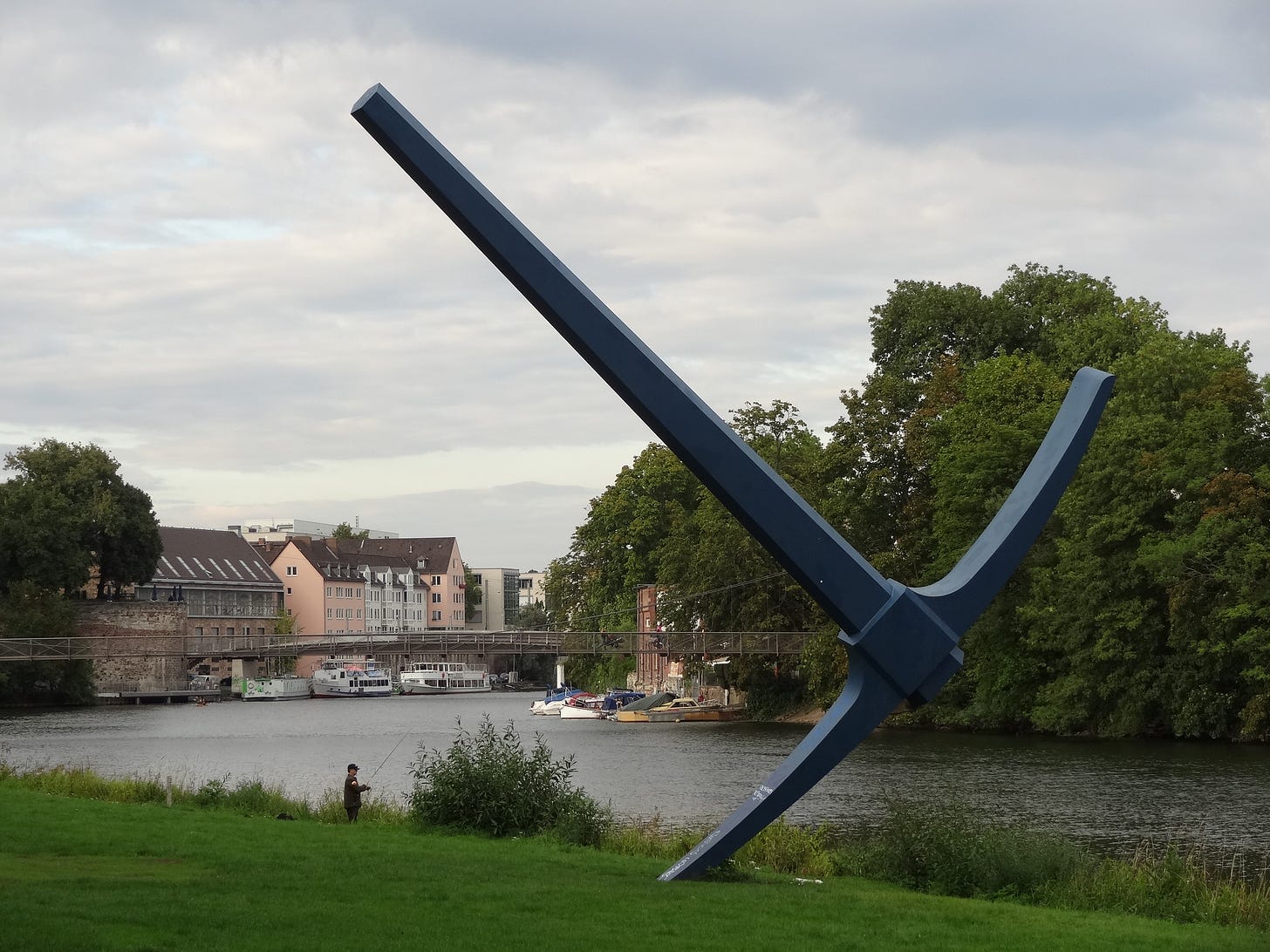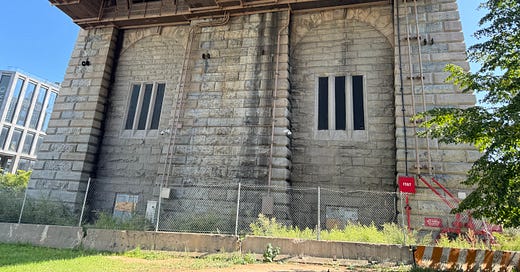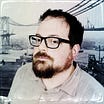[We are pleased to share this second guest essay in our Symposium on Public Space, contributed by Tobias Carroll. Tobias is the author of five books, most recently the novel In the Sight. He lives in New York and can be found online and on various social media platforms. While Tobias’s essay was written and conceived independently, it resonates with Geoff Kurtz’s earlier guest essay on contemplative public space. We hope you enjoy them both. —T. & Dh.]
Friends, we’ll begin with the sight of it: string after string of tiny LED lights suspended what seemed like a hundred feet or more above our heads, creating a pattern somewhere between a grid and a starfield. In my memory it seems endless, as though we all stood there beneath some alternate form of night.
And the smell! God, the smell. Like equal parts age and industry. Like coming to rest inside some cavernous machine. Spend enough time in enough places and you’ll start making connections between sites that have no business being connected; in my time on this earth I’m regularly surprised by the number of locations that recall the cafeteria of my old high school that are neither cafeterias nor remotely academic in their setting. And so, again, this place where I saw stars that were not stars and I smelled the kind of age I didn’t think you got outside of medieval cathedrals was nothing like anywhere I’d been before. In that brief moment staring up at those lights, I saw a sense of mystery and potential. I thrilled at what I might see in that same space in the future.
Even now, almost twenty-four years later, it’s hard to put it into context. Turns out I’d never set foot there again.
For eighteen years, the public art group Creative Time held an annual event called Art in the Anchorage. Held inside of the Brooklyn Bridge Anchorage and open to the public, the series provided installation artists with a place to create temporary installations inside part of a bridge — including Erwin Redl’s Matrix IV: the installation that has now etched itself into my brain. A series of strands with embedded LED lights at regular intervals dangled down from dozens of feet in the air. This created the effect of a translucent curtain with an implicit grid of lights over the course of about fifty feet. Calling it an optical illusion wouldn’t be entirely accurate, but the installation shared some qualities with one.
As with so many things, I came in near the end. My first time attending Art in the Anchorage was in the late summer of 2001. (You can probably figure out why that was also the last time it was held.) The following year, Creative Time held something similar in the buildings around the bridge, but it felt fundamentally different; art in the open air felt different than art inside a chamber.
I can remember my own qualified disappointment upon hearing about the end of Art in the Anchorage, but I couldn’t remember if there was a greater sense of cultural loss that accompanied the news. Turns out there was; writing in the Village Voice in the summer of 2002, C. Carr called the anchorage “probably the city's most unusual and spectacular space for art.”

At the time, the Creative Time team Carr spoke with held out hope that art might return there. More than twenty years later, that hope has zeroed out.
As Carr put it: “Art in the Anchorage has ended for reasons of national security.” There are many reasons why public art comes to an end: feuds between artists; feuds between artists and patrons; natural disasters; a loss of funding; a loss of a space. “National security” may well be the most all-consuming. Even as I entirely understand the very valid reasons why the Brooklyn Bridge Anchorage hasn’t hosted an event since 2001, I lament its continued absence.
In that same Voice article, Carr wrote of the Anchorage that “[j]ust walking in could produce a hushed moment.” For me, that gets at the appeal of what certain pieces of public art can accomplish: a sense of transportation or transcendence, or a glimpse into the personal and sacred. I got a very different sense of that years later, when I stood in David Byrne’s Playing the Building, another work produced under Creative Time’s aegis, in which an aging building became a vast instrument controlled by a single keyboard. Something familiar — some part of the urban landscape, generally off-limits to the general public — gives way to art and expression. These moments are few and far between in cities; when you do happen upon them, they drill down in your memory, becoming landmarks there along with their physical counterparts.
What Art in the Anchorage brought to the city was something specific to its space: a viewing experience that was simultaneously public and private. Public, because it literally was: anyone could attend, and there was no charge to do so. Private, because there’s something about that indoor space that feels secluding, even in a nominally crowded space. Think of it as the best aspects of both: the communal experience of public art alongside the singular feel of experiencing a work of art one-on-one.
Cards on the table here: I’m someone who looks for transcendent moments in art in all its forms. I’m drawn to the large-scale work of painters like Julie Mehretu and Mark Rothko in part because of its power to overcome, the sheer scale of it. You can lose yourself in these; you can lose yourself in a high-volume set by My Bloody Valentine or a hushed one by Julie Byrne. (And even as you lose yourself in any of these things, you can also find small imperceptible details to hone in on and obsess over. Art’s strange like that.) In his book Confabulations, John Berger memorably described the transportative ability of memorable art. “A few days ago I was standing in front of a painted image, measuring two meters by two, of paradise,” Berger writes. “And after a moment, standing still, gasping a little, I entered it.” Later in the same essay, he’ll revisit that same image after he’s added more context, followed by the succinct conclusion, “Such is art.”
As Anish Kapoor, the sculptor behind one of the country’s best-known works of public art — Chicago’s Cloud Gate — explained in a 2019 interview, the size of that work exists in a fluctuating contrast with the city around it. “When you’re close to the object, it is very big and when you move a little bit away from it, it’s not so big,” Kapoor said. “Especially in the scale of Chicago.” For temporary works of public art, that scale can also make a difference. Regarding Sugar, a temporary work of art on the Brooklyn waterfront, Kara Walker said, “I have this fantasy that once the installation comes down, the sphinx’s presence will somehow remain.”
What worries me when considering the loss of Art in the Anchorage and spaces like it is the loss of moments of quiet transcendence in unexpected places. Consider sculptor Claes Oldenburg, who opened “I Am For an Art” by declaring, “I am for an art that is political-erotic-mystical, that does something other than sit on its ass in a museum.” These aspects may vary in proportion depending on the work of art, but the appeal is clear. And perhaps, as Oldenburg suggests, those are qualities that are magnified when art is found in an unexpected location.

I’m torn between possible reasons why experiences like this seem to be in decline. I think some of it is simply that this kind of art thrives in spaces that are themselves in flux, and there are fewer and fewer buildings like that in New York and elsewhere. The David Byrne installation mentioned earlier? That took place in the Battery Maritime Building prior to it being renovated; you can’t place an art installation of that scale there any longer because the building now has dedicated functions. It’s a place with a function rather than an instrument to be manipulated.
At my most contentious, I wonder if there’s also a political component at work, if the official response to Occupy Wall Street over a decade ago left the municipal authorities in charge of approving such installations with a reluctance to okay something that might lead to protest and dissent. (Public art projects set to coincide with the 2016 Olympics in Rio were cancelled, leading one affected artist to believe political concerns were to blame. And a 2020 ARTnews article outlined the growing tendency of public art of any sort to become a political flashpoint.) And while I’m not sure I entirely believe in this interpretation, it is worth considering that Occupy Wall Street’s origins can be found in an image itself invoking a piece of public art, Arturo Di Modica’s Charging Bull. Art can be a tourist attraction or a backdrop for a selfie; it can still also spark change.
There’s also the tech-supremacist case. As I write this, a group of public and private entities is sponsoring an augmented reality version of The Gates, a 2005 installation by Christo and Jeanne-Claude, in Central Park, to celebrate its twentieth anniversary. In an especially biting essay on the installation’s virtual return, Hell Gate’s Nick Pinto argued that it “completely misses the point of the original artwork” and called it “the public art version of hologram Tupac.” In the same essay, Pinto also hailed the appeal of the original version of The Gates: the way that it turned the familiar landscape of Central Park into something new.
In a 2015 essay, critic Jerry Saltz memorably argued that public art had become a tool in the hands of developers, which has led to a sharp alteration in what we get from such spaces. “People here are not immersed but deeply controlled,” he wrote of the not-quite-private, not-quite-public spaces that have abounded across New York and other cities in the last few decades. For Saltz, the boundary between public art and public installation has to do with how someone approaches the work in question—and when. In this reading, there’s an acknowledgement that certain spaces across the city (across any city) can be encountered under almost any conditions. As art and development become increasingly intertwined, Saltz asks, what does that do for both? We’re still reckoning with that question now, a decade later.
There’s also the matter of accessibility. Public art can be immersive and thought-provoking; it’s also, by and large, free. Cities abound with other memorable immersive experiences, from London’s The Burnt City to the Rain Room installation at MoMA more than a decade ago. The quality of being overwhelmed by an artistic work can be found in a host of contexts, to be sure, but there’s something especially appealing about one available without a financial transaction being made. At a point when certain crucial aspects of cities can seen off-limits to those without deep pockets or a meticulously-arranged schedule, there’s an appeal for the universal, for the accessible, for the surprising.
In her book New Jersey as Non-Site, curator Kelly Baum has plenty to say about the relationship between art and location, but one sentence stands out for me: “Art is by no means reducible to the place where it was made, but neither is the place where it was made superfluous to what it means and how it operates.” What happens when both place and art are gone, either razed to the ground or locked away? After all, you can only have so many transformative experiences with a memory.
Even during a time when public art budgets are falling and appreciation for the arts feels perilous, the appeal of large-scale public art persists. As for what that might resemble as we move further into the century, it seems less likely to have one form than an endlessly shifting series of them. One form might involve the remixing or critiquing of existing public art and monuments, as when a statue of writer Indro Montanelli in Milan was transformed into a critique of Montanelli and Italian colonialism. Another could venture in a more absurdist direction, as when an anonymous artist in Melbourne created a series of bizarre, puckish works of public art. If public funding isn’t present and private funding is too stifling, the next work of public art that helps to crack the world open might require a more DIY approach. Perhaps the urban public art of tomorrow will look more like Sabato Rodia’s Watts Towers than anything created this century to date. If it surprises and inspires, so be it.





